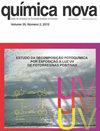NANOPARTÍCULAS DE SÍLICA (NPSiO2) UTILIZADAS PARA O TRATAMENTO DE DISTÚRBIOS ASSOCIADOS AO SISTEMA NERVOSO CENTRAL (SNC)
IF 0.5
4区 化学
Q4 CHEMISTRY, MULTIDISCIPLINARY
引用次数: 0
Abstract
SILICA NANOPARTICLES (SiO2NP) USED FOR THE TREATMENT OF DISORDERS ASSOCIATED WITH THE CENTRAL NERVOUS SYSTEM (CNS). In the last decade, nanomedicine has investigated the potential use of silica nanoparticles for drug delivery due to the favorable physicochemical properties of these systems as carriers. Specifically, a few studies have focused on applying silica-based nanosystems to deliver drugs into the central nervous system to treat neurological disorders. The present review aimed to evaluate the properties of silica nanoparticles, such as size, zeta potential, surface area, entrapment efficiency, drug loading, and release profile, exclusively applied for the treatment of central nervous system disorders as well as to describe the correlation between biological outcomes and physicochemical properties. Furthermore, the main processes related to the development of silica nanoparticles, such as preparation and characterization methods, were covered in this review to aid the systematic development of silica-based nanoparticles. In the articles reviewed, silica nanocarriers used in neurological disorders did not exhibit physicochemical similarities. Thus, attempts to prospect relations between physicochemical properties and biological effects are still inefficient when silica nanoparticles are used as drug delivery systems in neurological disorders. Therefore, each silica-based nanocarrier must be fully physicochemical and biologically characterized to comprehend how the structural features of silica nanoparticles affect biological systems.二氧化硅纳米颗粒(NPSiO2)用于治疗与中枢神经系统(CNS)相关的紊乱
二氧化硅纳米颗粒(SiO2NP)用于治疗与中枢神经系统(CNS)相关的疾病。在过去的十年中,纳米医学已经研究了二氧化硅纳米颗粒作为药物递送载体的潜在用途,因为这些系统具有良好的物理化学性质。具体来说,一些研究集中在应用硅基纳米系统将药物输送到中枢神经系统以治疗神经系统疾病。本文综述了二氧化硅纳米颗粒的大小、zeta电位、表面积、包载效率、载药量和释放谱等性能,并对其在中枢神经系统疾病治疗中的应用进行了综述。此外,本文还综述了二氧化硅纳米颗粒的制备和表征方法,以帮助系统地开发二氧化硅基纳米颗粒。在回顾的文章中,用于神经系统疾病的二氧化硅纳米载体没有表现出物理化学相似性。因此,当二氧化硅纳米颗粒被用作神经系统疾病的药物传递系统时,展望物理化学性质和生物效应之间关系的尝试仍然是低效的。因此,每一种硅基纳米载体必须具有完整的物理化学和生物学特征,以了解二氧化硅纳米颗粒的结构特征如何影响生物系统。
本文章由计算机程序翻译,如有差异,请以英文原文为准。
求助全文
约1分钟内获得全文
求助全文
来源期刊

Quimica Nova
化学-化学综合
CiteScore
1.60
自引率
12.50%
发文量
72
审稿时长
2-4 weeks
期刊介绍:
Química Nova publishes in portuguese, spanish and english, original research articles, revisions, technical notes and articles about education in chemistry. All the manuscripts submitted to QN are evaluated by, at least, two reviewers (from Brazil and abroad) of recognized expertise in the field of chemistry involved in the manuscript. The Editorial Council can be eventually asked to review manuscripts. Editors are responsible for the final edition of QN.
 求助内容:
求助内容: 应助结果提醒方式:
应助结果提醒方式:


